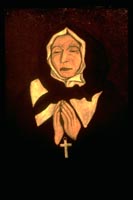|
The founder of the Congrégation de Notre-Dame, Marguerite Bourgeoys, was also involved in the origin of
Notre-Dame-de-Bon-Secours chapel. When she arrived in Ville-Marie in 1653 there were no school-age children to teach.
She therefore spent her initial years visiting families, instructing women, managing the house of Governor Maisonneuve,
and providing various kinds of assistance to the inhabitants of Montréal. She also supervised the re-erection of the cross on
Mount Royal, the first pilgrimage site in Montréal. But as the route to that site had become too dangerous, she dreamed of
creating another pilgrimage site which she would dedicate to Our Lady. In 1657 she obtained ecclesiastical permission to
build a chapel on the edge of the St. Lawrence River.
|

Façade of
Notre-Dame-de-Bon-Secours Chapel |
|
 |
 |
First foundation stone of
the 1675 chapel |
|
|

Foundation stone of the 1771 chapel
|
|
The current chapel, which dates from 1771, was built over the foundations of the first stone church in Montréal. This first church,
which was erected between 1657 and 1678, marked the beginning of the oldest site in Montréal that has retained its original purpose.
Thanks to recent archaeological discoveries, it puts us in direct contact with the mystical foundation of Ville-Marie. The most precious
of the chapel's treasures is the oak statuette of Notre-Dame de Bon-Secours given to Marguerite Bourgeoys by the Baron de Fancamp in
1672. The baron, one of the first members of the Société de Notre-Dame de Montréal, was a benefactor of the chapel. Its wooden vault
was decorated in 1886 by François-Édouard Meloche.
|
Archaeological Digs
Between 1996 and 1998, extensive
restoration of the current chapel revealed major archaeological
discoveries. In the basement, under the nave of the current chapel,
archaeologists unearthed the foundations of the first chapel built
by Marguerite Bourgeoys. Measuring 13.80 by 7.50 metres, it was
a pilgrim's chapel where the populace would take refuge to seek
consolation, to pray and to give thanks to the Blessed Virgin at
the foot of the statuette brought by Marguerite Bourgeoys. Archaeologists
also discovered marks of posts from Montréal's wooden palisade,
which the archaeologists have dated to 1709. |

|
 |
|
The chapel and the museum |
|
The digs stopped at the scorched layer dating from the chapel fire of 1754. Fragments of melted glass inside the walls and of
calcined glass on the outside testify to the violence of the conflagration, which shattered the window panes. A portion of the
nave was deliberately excluded from the digs in order to preserve the graves of nine nuns buried there in 1734. Traces of
Amerindian hearths and artifacts which could date back 2400 years were found around the remains of the chapel. Many other
artifacts from the 17th and 18th centuries have also been discovered, notably plaster pipes, shells, glass beads and gun flints.
Fragments of a small blue and white earthenware holy water font which appear to date from the age of Marguerite Bourgeoys
were also found.
|
THE MARGUERITE BOURGEOYS MUSEUM
The Marguerite Bourgeoys Museum, which adjoins Notre-Dame-de-Bon-Secours chapel, consists of four rooms :
- the TROYES room, named after the town where Marguerite Bourgeoys was born. Here one may see part of the staircase
from her family home;
- the FIGURINES room, where the life of Marguerite Bourgeoys is traced in 58 display cases;
- the CONGREGATION room, which evokes the work of Marguerite Bourgeoys and the Congrégation de Notre-Dame by means of
virtual images. One can see Marguerite at work in the stable-school, at the Saint-Gabriel farmhouse, and at the La Montagne mission
where the nuns began teaching Amerindian girls in 1676;
- the TRUE PORTRAIT room, a place of meditation where the visitor can reflect upon the faith of Marguerite Bourgeoys through her
writings and the story of her true portrait.
|

|
Small trunk belonging to Marguerite Bourgeoys |
Marguerite Bourgeoys: the woman
When the Filles du Roy arrived in New France, Marguerite welcomed them in her house and prepared them for their roles as wives and
mothers. Later these women would turn to her for support and encouragement. She organized a first school of domestic arts, Maison Saint-Gabriel, to help the most disadvantaged women earn a living. She also sent her nuns, including two aboriginal women, to teach female
Amerindian students at the mission of La Montagne. Marguerite Bourgeoys died on January 12, 1700. She was canonized on October 31, 1982
by Pope John Paul II.
|
 Marguerite Bourgeoys
Marguerite Bourgeoys |
Marguerite Bourgeoys: the true portrait
The portrait of Marguerite Bougeoys that appears in many publications about New France was painted by Pierre LeBer on
January 12, 1700, immediately after her death. In the mid-20th century, some doubts were raised as to the authenticity of the LeBer
portrait. In 1963, an analysis of the painting by art restorer Edward Korany revealed the existence of a quite different work underneath
the familiar portrait. Following the removal of several repainted layers, the "true portrait" again emerged on LeBer's canvas. An amateur
painter employing a somewhat primitive technique, LeBer nonetheless had a descriptive power which transcended his technical
limitations. The portrait summarizes 80 years of a life wholly dedicated to the love of God and one's fellow human beings.
|
The sailors' chapel and lookout
In the chapel tower, an audio-visual presentation recalls the difficulties of an ocean crossing in times past. The lookout offers
an exceptional panorama of the Old Port, Old Montréal and the modern city, with an orientation of "in the footstep of
Marguerite Bourgeoys".
|
Notre-Dame-de-Bon-Secours Chapel/Marguerite Bourgeoys Museum
400 Saint-Paul Street East
Montréal (Québec) H2Y 1H4
Tel: (514) 282-8670 Fax: (514) 282-8672
|
|

